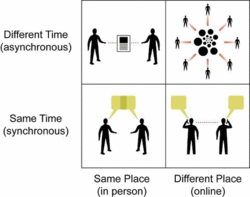Think of this as Volume 18, Number 19 of the newsletter I have written weekly since March, 1997. Enjoy.
 One of the biggest changes in society today is the move from synchronicity to asynchronicity.
One of the biggest changes in society today is the move from synchronicity to asynchronicity.
Most people grew up in a synchronous world. If you're meeting face-to-face, or you're on the telephone with someone, or even if you're actively text messaging back-and-forth, you are engaged in synchronous communication. The traffic is even on both sides, and you're both engaged at the same time.
Smartphones emphasize asynchronicity. They're not really phones at all. They are, as I've said for years, Internet clients. They're great for e-mail, for looking stuff up. They have calendar functions, cameras. They're computers, with broadband. Both 3G or 4G networks, and WiFi networks, have enough bandwidth so clients can handle video and audio as well as a desktop. Larger “phablets” and tablets run the same operating systems, and they often cost under $500.
In a synchronous world you have a work number and a home number. In an async world you are free to be everywhere and nowhere. You have a single number and an e-mail box.
Synchronicity can be a good thing. A trade show is a festival of synchronicity, of face to face meetings. The problem is such events don't scale well. The tech industry itself learned this in the 1980s and 1990s. Today most such events cater to crowds of under 10,000. The rest use asynchronous channels.
This year I agreed to head a bit of proto-government where neighbors comment on what the city is doing before the council takes them on. We were invited to City Hall for a talk on technology. For the first hour older neighbors railed about how rude people were on the phone. It was a synchronous issue, and the discussion was getting heated.
Then someone advising the city's computer department began describing an app he has helped create that lets people report on abandoned houses and downed trees. Suddenly the tone of the meeting changed. We were talking about making teens the advocates of their elders, using asynchronous means to get problems to the right people in City Hall. We were talking about self-service, about enabling access to city data 24/7, making it asynchronous, no operator required.
In a synchronous world both sides of every transaction must be synced in time. In an async world this is no longer necessary. It's asynchronicity that makes business a 24/7 proposition, that made Healthcare.gov possible. Asynchronicity frees people to do business wherever they happen to be, and on their schedule.
Here's an example. I went for a walk, with my smartphone. It rang. It was someone asking about a zoning change he wanted to bring up. But he didn't know if I was the right contact, and whether he needed to go to a second, neighborhood meeting first. I stopped, put him on hold, looked up the address he gave me, then told him precisely what meeting he needed to go to, and who he should talk to first. I continued on my walk, but before I finished I detoured to the relevant location and took some pictures. When the meeting happened we were both ready for it.
In a 20th century world, that phone call doesn't reach me. In a pre-smartphone world I can't interrupt a walk to do business, to access Web-based resources. I don't have the contacts he needs, I don't know whether I can help him at all. Now I've given him help without interrupting my walk, and researched the issue before I got home.
Asynchronicity can do as much for productivity as the PC did. Data, connection, and interaction are no longer tied to time and space. It's not that offices are becoming lounges with toys. It's that offices are with you everywhere. It's you who is connecting, not your office. There are no intermediaries, no gatekeepers, and there needs to be no delay in getting needed data from a repository to the person who needs it, or even in collecting it from the field.
The full impact of this has yet to be felt, in the design of our cities, or in our daily lives. We still think of living and working as being discrete activities, as belonging to different physical places, and periods of time.
They don't.
I joke with my lovely wife that I “retired” 30 years ago, when the Atlanta Business Chronicle decided that, instead of having me and my PC do the work of three men, they'd hire the three men and kick me to the curb. Since then I have worked when I needed to, and taken care of the house when I needed to.
In the 20th century this meant hanging by the phone, waiting for callbacks. I'd make my calls early in the morning, and usually get callbacks after the “working day” was done. They expected to get voice mail. I would interrupt dinner to take those calls and get my interviews, but it was frankly a pain.
Now everything I need to research a daily story is right at hand. If I need quotes I send an e-mail. Otherwise I put my work together using Web resources. I spend less than half the time I once did doing my job but it's the same job. I have more time to myself, and since I use most of that time to think, my work is better than ever.
My wife's bosses still want her there, but they let her stay home one day each week, and she's far more productive then than any other day. A little synchronicity, for meetings and serrendipity, may be necessary to keep teams on track. But most work can be done at home, and if you manage based on productivity it can be done when the employee feels most productive, rather than be limited to office hours.
This is why offices are dying, as factories did a generation ago, and are being replaced by campuses. As part of a city, campuses actually have more density than the office arrangement did, because you need to be in touch with human resources at any time of the day. Look at college towns like Athens, Georgia or Davis, California. They don't sprawl. They are tight, held together by peoples' needs to be around one another day and night. With urban campuses it's the same way – they increase the population density in existing neighborhoods rather than encouraging sprawl.
This is the asynchronous economy. It's not bound by the 9-5 workday. It's bound together by intense, shared interests, which increases living densities. It's a 24-7 world where you choose which hours to work.










